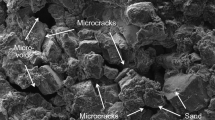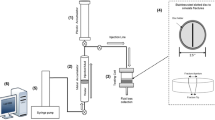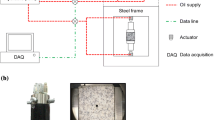Abstract
Wellbore instability has been registered and expected as one of the risks for successful delivery of horizontal injectors with open-hole stand-alone screens in depleted reservoirs. Special drill-in fluids and breaker fluids were designed to ensure stability of these wells prior to screen installations. Borehole collapse was expected in most cases after the wellbore pressure dropped to hydrostatic at the end of the drilling process. Unlike open-hole producers, the loose particles (or grains) trapped in the annulus of the open-hole injectors will likely undergo constant mixing and resorting during each injection and shut-in cycles. In this study, we examined the impacts of grain mixing on the reduction of porosity and permeability in the annulus using a simple binary mixing model. Laboratory experiments based on this hypothesis have also been conducted. Our preliminary results suggest that if the fines are 10 to 20 times smaller than the larger particles, the presence of a few percent in volume fraction of fine particles can reduce permeability by an order of magnitude. The predicted reductions are consistent with the observed equivalent skin increases at some of our injectors during the first few years of operations. After multiple stimulations to remove fines and residual drilling additives, we successfully re-established injectivities to the initial states.






Similar content being viewed by others
Abbreviations
- S well :
-
Skin
- K res :
-
Reservoir permeability
- K annulus :
-
Permeability of the annulus
- R annulus :
-
Radius of the open-hole size
- R w :
-
Radius of outer diameter of the screen
- K V :
-
Vertical permeability
- K h :
-
Horizontal permeability
- ϕ :
-
Porosity of binary mixture
- ϕ D :
-
Initial porosity of the larger particles
- ϕ d :
-
Initial porosity of the smaller particles
- X D :
-
Volume fraction of the larger particles
- X d :
-
Volume fraction of the smaller particles
- δ :
-
Ratio smaller versus larger particle sizes
- K :
-
Permeability
- B :
-
Geometric factor in Kozeny–Carman relationship
- T :
-
Tortuosity
- S :
-
Surface area
- n :
-
Ratio of size of larger versus smaller particles
References
Beard DC, Weyl PK (1973) Influence of texture on porosity and permeability of unconsolidated sand. Am Assoc Pet Geol Bull 57(2):349–369
Clarke RH (1979) Reservoir properties of conglomerates and conglomeratic sandstones. Am Assoc Pet Geol Bull 63:799–809
Dias R, Teixeira JA, Mota M, Yelshin A (2006) Tortuosity variation in a low density binary particulate bed. Sep Purif Technol 51:180–184
Feia S, Dupla JC, Ghabezloo S, Sulem J, Canou J, Onaisi A, Lescanne H, Aubry E (2015) Experimental investigation of particle suspension injection and permeability impairment in porous media. Geomech Energy Environ 3:24–39
Fjaer E, Holt R, Horsrud P, Raaen AM, Risnes R (2008) Petroleum related rock mechanics, 2nd edn. Elsevier, Oxford, p 491
Furnas CC (1929) Flow of gases through beds of broken solids, vol 307. Bulletin U.S. Bureau of Mines, Washington, DC, p 144
Gaither A (1953) A study of porosity and grain relationships in experimental sands. J Sediment Pet 23(3):180–191
Golovin E, Zhang H, Chudnovsky A, Dudley JW, Chan AW, Mikulencak D (2018) Observations of injectivity reduction from a near-wellbore mixing under cyclic injection into unconsolidated sand. ARMA, Overland Park, pp 18–164
Han D, Nur A, Morgan D (1986) Effects of porosity and clay content on wave velocities in sandstones. Geophysics 51(11):2093–2107
Jaeger JC, Cook NGW, Zimmerman RW (2007) Fundamentals of rock mechanics, 4th edn. Blackwell Publishing, Oxford, p 475
Koltermann CE, Gorelick SM (1995) Fractional packing model for hydraulic conductivity derived from sediment mixtures. Water Resour Res 31:3283–3297
Krumbein WC, Monk GD (1942) Permeability as a function of the size parameters of unconsolidated sand. Tech Publ Am Inst Min Metall Eng 1492:11
Marion D (1990) Acoustical, mechanical and transport properties of sediments and angular materials. PhD dissertation, Stanford University, Stanford, California, pp 136
Marion D, Nur A, Yin H, Han D (1992) Compressional velocity and porosity in sand-clay mixtures. Geophysics 57(4):554–563
McGeary RK (1961) Mechanical packing of spherical particles. J Am Ceram Soc 44:513–522
Morrow NR, Huppler JD, Simmons AB (1969) Porosity and permeability of unconsolidated upper Miocene sands from grain size analysis. J Sediment Pet 39(1):312–321
Mota M, Teixeira JA, Bowen WR, Yelshin A (2001) Binary spherical particle mixed beds: porosity and permeability relationship measurement. Trans Filtr Soc 1(4):101–106
Revil A, Cathles LM III (1999) Permeability of shaly sands. Water Resour Res 35:651–662
Santarelli FJ, Skomedal E, Markestad P, Berge HI, Nasvig H (2000) Sand production on water injectors: how bad can it get? SPE Drill Complet 15(2):132–139
Suzuki M, Makino K, Yamada M, Iinoya K (1981) A study on the coordination number in a system of randomly packing, uniform-sized spherical particles. Int Chem Eng 21(3):482–488
van den Hoek PJ, Kooijman AP, de Bree F, Kenter CJ, Zheng Z, Khodaverdian M (2000) Horizontal wellbore stability and sand production in weakly consolidated sandstones. SPE Drill Complet 15(4):274–283
van Everdinger AF (1953) The skin effect and its influence on the productive capacity of a well. Trans AIME 198:171
Westman AER, Hugill HR (1930) The packing of particles. J Am Ceram Soc 13:767–779
Yu AB, Zou RP, Standish N (1996) Modifying the linear packing model for predicting the porosity of non-spherical particle mixtures. Ind Eng Chem Res 35(10):3730–3741
Zaman E, Jalali P (2010) On hydraulic permeability of random packs of monodisperse spheres: direct flow simulations versus correlations. Phys A 389:205–214
Acknowledgements
The authors would like to thank Shell managements for the permission to publish this paper. We would also like to acknowledge our colleagues who have provided their valuable insights, challenges, and suggestions over the years to improve the quality of this work. We are also grateful to the ARMA 2018 organizing committee for selecting our works in this publication and to the guest editors and reviewers for their suggestions and feedback on how to improve this manuscript.
Author information
Authors and Affiliations
Corresponding author
Ethics declarations
Conflict of interest
The authors declare that they have no conflict of interest.
Additional information
Publisher's Note
Springer Nature remains neutral with regard to jurisdictional claims in published maps and institutional affiliations.
Given the insufficient time to seek additional approvals for new technical data releases, we can only made minor updates to the paper originally submitted for ARMA 2018 symposium in Seattle.
Rights and permissions
About this article
Cite this article
Chan, A.W., Yadav, S. & Mikulencak, D.R. From Wellbore Instability and Grain Mixing to Injectivity Reduction. Rock Mech Rock Eng 52, 5195–5204 (2019). https://doi.org/10.1007/s00603-019-01886-6
Received:
Accepted:
Published:
Issue Date:
DOI: https://doi.org/10.1007/s00603-019-01886-6




